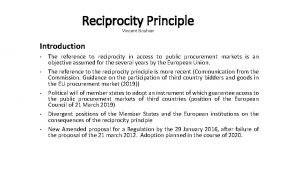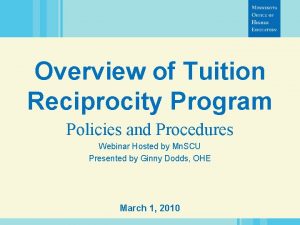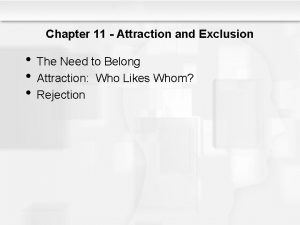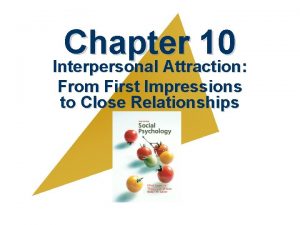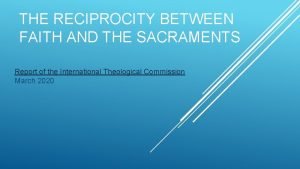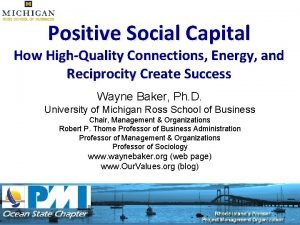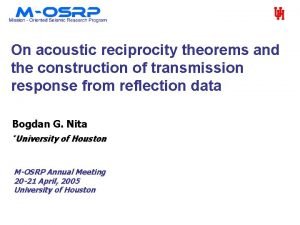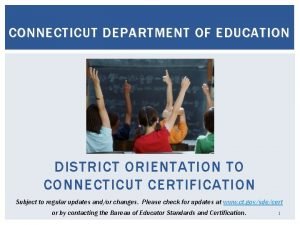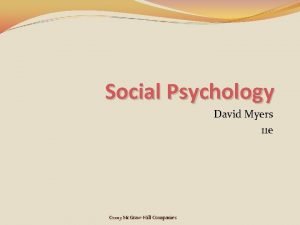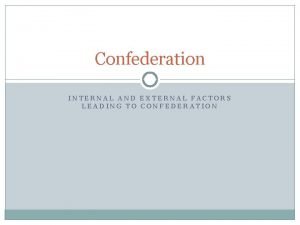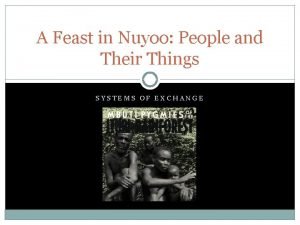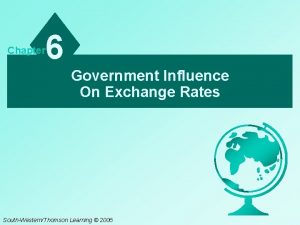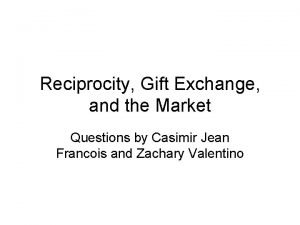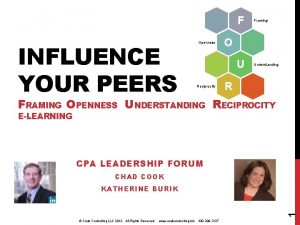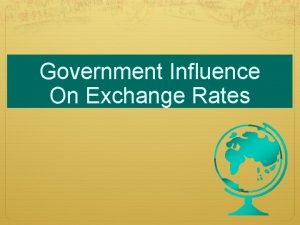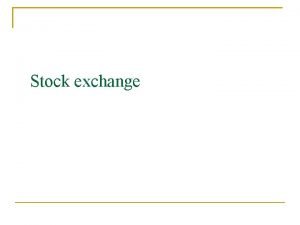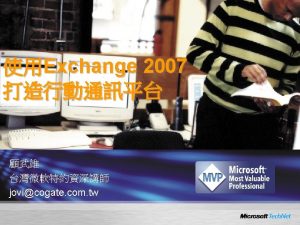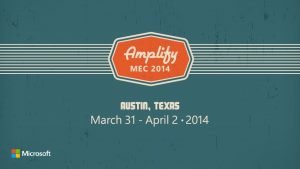DESIGNING RESEARCH TO INFLUENCE POLICY RECIPROCITY AND EXCHANGE
![DESIGNING RESEARCH TO INFLUENCE POLICY: RECIPROCITY AND EXCHANGE [PART I] BY LORNE FOSTER YORK DESIGNING RESEARCH TO INFLUENCE POLICY: RECIPROCITY AND EXCHANGE [PART I] BY LORNE FOSTER YORK](https://slidetodoc.com/presentation_image_h2/8eae99f7231bbe08dca976cb42588b2b/image-1.jpg)

















- Slides: 18
![DESIGNING RESEARCH TO INFLUENCE POLICY RECIPROCITY AND EXCHANGE PART I BY LORNE FOSTER YORK DESIGNING RESEARCH TO INFLUENCE POLICY: RECIPROCITY AND EXCHANGE [PART I] BY LORNE FOSTER YORK](https://slidetodoc.com/presentation_image_h2/8eae99f7231bbe08dca976cb42588b2b/image-1.jpg)
DESIGNING RESEARCH TO INFLUENCE POLICY: RECIPROCITY AND EXCHANGE [PART I] BY LORNE FOSTER YORK UNIVERSITY

RESEARCH AND PUBLIC POLICY OUTLINE I) II) Situating the Academic Research Tradition in the “Public Policy Space” Sources / Authority / Influence Model-ling [And Trends Toward] n n III) Collaborative knowledge model Knowledge mobilization Conclusions Enhancing Research-Action Linkages n n Toward systematic advice on how to maximize the academic impacts of research Policy entrepreneurship [issues require entrepreneurial responses from researchers]

DEFINITIONS n n n Public Policy – “A decision or action of government that addresses problems and issues. ” www. congresslink. org/print_lp_whyneedcongress_vocc b. htm Public Policy-Making – “The process by which governments translate their political vision into… actions to deliver changes in the real world. ” www. policyhub. gov. uk/evalpolicy/index. cap The Policy Cycle – “The steps that display the sequential flow, or a logical sequence of recurring events, in the policy process. ” http: //profwork. org/pp/study/cycle. html

THE POLICY CYCLE

THE SCIENTIFIC TRADITION ‘THE CALLING’ The responsibility of academic research is “to marshal evidence and explanations so as to help to mobilize forces of change” – John Porter (1987: 3 – The Measure Of Canadian Society) In Porter’s sense, academic research is about gaining understanding in order to provide people with participatory resources.

THE OSMOSIS STRATEGY Conventionally, clinical and/or social research has been conceived as having osmotic properties – where it ‘naturally’ penetrates the membrane(s) of society – as a higher concentration of intelligence it equalizes the intelligence solution of society. A) Self-deprecating ‘lab ratting’ (under estimating import of work) B) Self-denying “ivory towerism” (knowledge for knowledge sake) C) Self-aggrandizing ‘scientism’ (unproblematic/ authoritative discourse)

THE RECIPROCITY AND EXCHANGE LENS n n Today research is more and more recognized as one actor in the public policy-making process Today most researchers understand it’s no longer enough to do research, write up the results and present them at a conference of like-minded peers The work has to be mobilized–out of the ivory tower and into the hands and minds of those who will use it to shape emerging policies and practices. Mobilize the forces of social change by mobilizing research out of its ivory tower

CONDISERING THE POLICY-MAKING SYSTEM TODAY n n 1) 2) As Carol Weiss notes, ‘‘instead of concentrating solely on the effect of research on individuals in policymaking positions [evaluators] have begun to take the policy-making system as their canvas’’ (Weiss 2003: 5). What does this mean? Two things, ‘process’ and ‘structure’: Research is one actor in the public policy-making process. Build stakeholder considerations into your research [i. e. , collaborative knowledge building models].

WHO INFLUENCES PUBLIC POLICY: THE POLICY-MAKING SYSTEM AS CANVAS Media Stakeholders (Eg. , Interest Groups, Advocacy Organizations, Elected Officials Constituencies, etc. , ) Public Policy Research Funders, Makers Research Entities (Legislators) (Eg. , Academic Research Organizations, Think Tanks, ect. , )

FISCALIZED NEOLIBERALISM AS A CONTEXT n n n Blending political views with emphasis on economic growth and market reasoning – free market methods and profit motives. The elevation in the importance of this ‘fiscalized consciousness’ is often traced to the Johnson Administration – 1960 s – ‘Great Society Reforms’ – birth of “program evaluation”. Similarly in Canada – the 1990 s is said to marked the rise of ‘the debt, deficit, budgetary balance & surplus’ discourses that still dominate policy space.

POLITICIANS AND SENIOR CIVIL SERVANTS: PUPLIC POLICY DECISION MAKERS They want research to be (1) collaborative (2) outputfocused [service definitions and measures] I. Bang for buck – fiscal / fiduciary responsibility II. Reduce government ‘foot print’ III. Program evaluation with an outcome focus In other words, researchers are often expected to be involved throughout the policy cycle – agenda-setting, option-formation, implementation & evaluation.

TRANSLATING RESEARCH INTO POLICY AND PRACTICE n To enhance the uptake of evidence-based interventions, several steps are needed to move science/ evidence-based research upstream: 1) creating a research-use strategy 2) place greater emphasis on workforce development/ outcome-focused 3) developing multi-format communication products 4) breaking down barriers to usage 5) using feedback effectively

POLICY SPACE TRENDS CENTRAL TO MODERN OR POST-MODERN EPISTEMIC PRACTICE n n n The reciprocity-exchange lens implies the authority of a more ‘collaborative market-based knowledge’ model for policy space Collaborative knowledge management [in terms for the creation, exchange, and transformation of knowledge] Collaborative and out-put focused [service definitions and measures] Cross-sector solutions to complex problems Relationships and networks [as opposed to concentrating solely on the effect of research on individuals in policymaking positions’’]

RECIPROCITY AND EXCHANGE TOOLBOX n n n Knowledge Mobilization – process to make research matter more in policy and practice for the benefit of society “…moving knowledge into active service for the broadest possible common good. ” (SSHRC, 2008, para 5) Community Engagement – “The purpose of community engagement is to involve the public in decisions that will ultimately affect their lives. This requires interaction and communication between citizens, scientists and policymakers. ” (Institute for Resources, Environment and Sustainability, 2003). Social Innovation – is a novel solution to a social problem that is more effective, efficient, sustainable, or just than present solutions and for which the value created accrues primarily to society as a whole rather than private individuals. http: //csi. gsb. stanford. edu/social-innovation

SIX LESSONS HELPING RESEARCHERS BECOME POLICY ENTREPRENEURS 1. 2. 3. 4. 5. Policy processes are complex and rarely linear or logical. Many policy processes are only weakly informed by research-based evidence. Research-based evidence can contribute to policies that have a dramatic impact on lives [careful combination of pilot field-level projects, institutional research and proactive communication]. Policy entrepreneurs need a holistic understanding of the context in which they are working [social contexts of issues and solution]. Policy entrepreneurs need clear intent [building multidisciplinary teams,

POLICY ENTREPRENEURSHIP n n A policy entrepreneur can be defined as “an individual who exploits an opportunity to influence policy outcomes in order to maximize his/her self interests – without having the resources required for achieving this goal alone” (Cohen, 2011). Policy entrepreneurship can be understood within more encompassing theorizations of policy change: incrementalism, policy streams, institutionalism, punctuated equilibrium [spurt theory], and advocacy coalitions. Recent applications of policy entrepreneurship as a key explanation of policy change are presented as models for future work. Room exists for further conceptual development and empirical testing.

WHAT WOULD A SYSTEMATIC AND ENTREPRENEURIAL APPROACH LOOK LIKE? n n n Recognizing academic-based research is only one type of evidence that informs government decision-making Early and ongoing involvement of decision-makers Build the desired outcome into the research design Recognize research and decision-making linkages are less of a product or event, but are on-going social processes. Partnering competency – ‘relational contracting’ competencies Community engagement Facilitate collaborative research Knowledge mobilization [Knowledge transfer] User -oriented program evaluation approach Knowledge brokers should be the prime focus for km and kt activities by academics and community researchers. Multi-formatted public communication

CONCLUSIONS n n I. III. Research has to be reciprocity-and-exchange centred to ‘mobilized–out’ of the ivory tower and into the hands and minds of those who will use it to shape emerging policies and practices. Researchers need to design and conduct studies that are policy relevant and to develop outcome-strategies to translate their research into policy and practice stakeholder consultation – linkage with those most directly affected knowledge mobilization – build stakeholder’s considerations into your research accessibility – in multiple formats
 Vincent bouhier
Vincent bouhier Reciprocity program
Reciprocity program Reciprocity of attraction
Reciprocity of attraction Moreland and beach (1992)
Moreland and beach (1992) Reciprocity of attraction
Reciprocity of attraction Propinquity attraction
Propinquity attraction Proximity in a relationship
Proximity in a relationship Reciprocity religion
Reciprocity religion Reciprocity ring examples
Reciprocity ring examples Wvu mountaineer hub
Wvu mountaineer hub Reciprocity theorem experiment
Reciprocity theorem experiment Ct sde certification lookup
Ct sde certification lookup Linearity property circuits
Linearity property circuits Reciprocity norm
Reciprocity norm Reciprocity norm
Reciprocity norm Reciprocity treaty cancelled
Reciprocity treaty cancelled Potlatch reciprocity
Potlatch reciprocity Government influence on exchange rates
Government influence on exchange rates Addison currency exchange
Addison currency exchange
